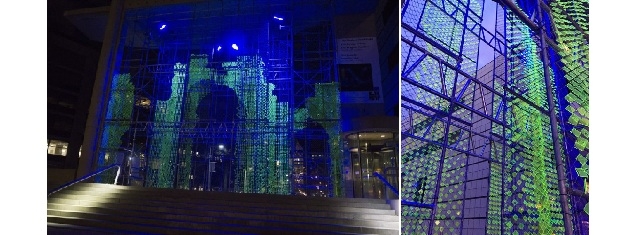Travel
MIT Program announced Five guided artist tours of the Memory Matrix
A Monument to Future Heritage

Azra Aksamija, Memory Matrix at MIT, 2016 (Source: Massachusetts Institute of Technology )
USPA NEWS -
In conjunction with the centennial celebration of MIT's move from Boston to Cambridge ““ running from Apr 23 to May 7 - the MIT Program in Art, Culture and Technology (ACT) is hosting five guided tours of the Memory Matrix project led by the artist and ACT Assistant Professor Azra Aksamija...
In conjunction with the centennial celebration of MIT's move from Boston to Cambridge ““ running from Apr 23 to May 7 - the MIT Program in Art, Culture and Technology (ACT) is hosting five guided tours of the Memory Matrix project led by the artist and ACT Assistant Professor Azra Aksamija and invites the public to participate. Created through collaborative and transdisciplinary efforts, this public space installation explores how art and cultural heritage can play a role in promoting greater sensitivity to loss in other countries.
At this very moment, our history is being rewritten through the destruction and looting of cultural heritage in Syria, Iraq, Yemen and other regions that are currently suffering acute conflict and crisis. Culture has become a central target of war and conflict because cultural heritage is often powerful evidence of our (co)existence. With this monument-in-the-making, Aksamija and her collaborators are exploring how communities threatened by war can document their material and immaterial heritage as indestructible evidence.
The monument itself is made of border fences carrying over 20,000 small fluorescent Plexiglas elements or 'pixels.' These elements are laser cut with holes outlining vanished and threatened heritage from different parts of the world. Each pixel also bears a code that is linked to the project website and databank. The larger matrix of pixels reveals an image of the recently destroyed Arch of Triumph from the ancient city of Palmyra (Syria), made visible through the movement of light and wind. Palmyra is one of the most important cultural centers of the ancient world and was listed as UNESCO World Heritage Site.
The Memory Matrix's collaborative making process, which involves students from across the campus and beyond, directly references MIT founder William Barton Roger's vision of hands-on collaboration. It is also inspired by the ethos and tireless peace advocacy of MIT's 13th President Jeremy Wiesner, after whom the building E15 is named. More than an art installation, the Memory Matrix is a solidarity-building and educational enterprise, and an attempt to seed support for Syrian refugees.
Source : Massachusetts Institute of Technology
Ruby BIRD
http://www.portfolio.uspa24.com/
Yasmina BEDDOU
http://www.yasmina-beddou.uspa24.com/
Source : Massachusetts Institute of Technology
Ruby BIRD
http://www.portfolio.uspa24.com/
Yasmina BEDDOU
http://www.yasmina-beddou.uspa24.com/
Ruby Bird Yasmina Beddou Monument Future Heritage Guided Artist Tours Memory Matrix Mit Program Art Culture And Technology Centennial Celebration Of Mit Cambridge Boston
Liability for this article lies with the author, who also holds the copyright. Editorial content from USPA may be quoted on other websites as long as the quote comprises no more than 5% of the entire text, is marked as such and the source is named (via hyperlink).






